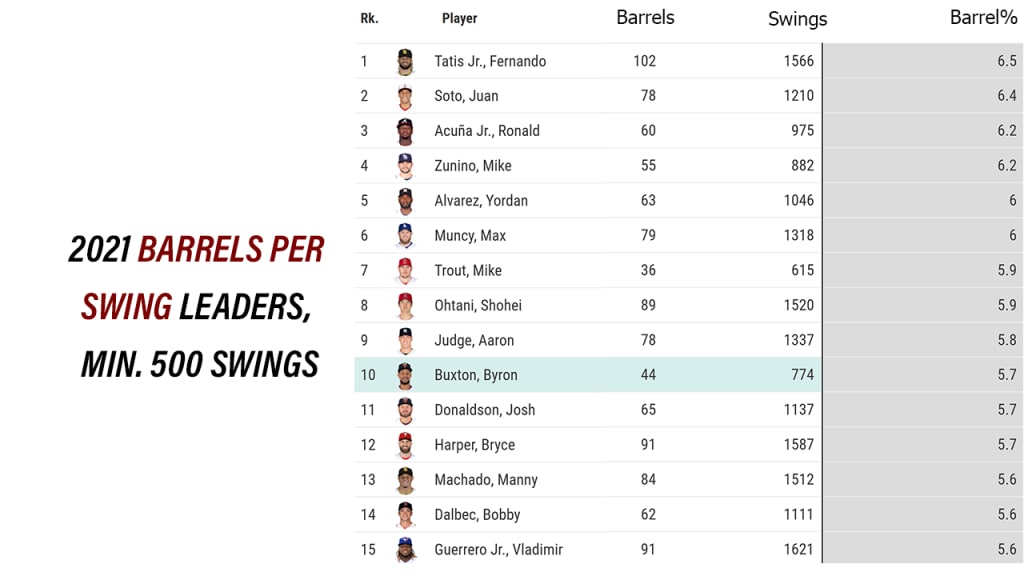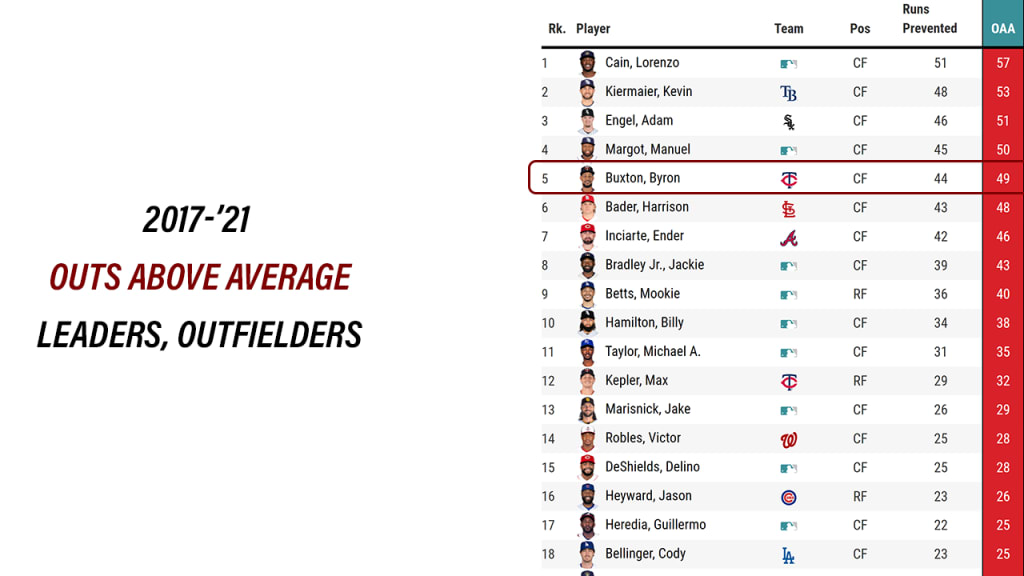Byron Buxton, who has stayed healthy enough to collect 350 plate appearances in a season exactly once in his seven-year career (and that came back in 2017), just collected a guaranteed $100 million from the Twins, and you’re shocked at how much money that is for a player who’s rarely been on the field. Since 2016, 220 players have had more plate appearances -- including Joe Mauer, who retired after 2018.
That’s one way to look at it. Here’s another.
Buxton, a game-changing defensive center fielder with truly elite speed who also hit 42 home runs with a .575 slugging percentage and a 137 OPS+ from 2019-21 -- in 684 plate appearances, or roughly a full season -- just collected a guaranteed $100 million, and you’re shocked at how little that is. In a mere 61 games in 2021, he collected 4.2 WAR, tied for 35th in baseball with such players as Tim Anderson and Austin Riley.
Since 2017, Buxton is 237th in plate appearances … but 71st in WAR.
If it feels like this contract is both “too much” and “too little” all at the same time, that’s exactly right. A fully healthy Buxton is a $300-million-or-more free agent, right up there with the Harpers, Trouts and Tatises of the world, because almost no one can match his combination of power, speed and defense. A limited Buxton requires the Twins to squeeze Nick Gordon, Rob Refsnyder, Jake Cave and others like them into center field.
It is, in many ways, an unprecedented contract (in part because of considerable incentives that could nearly double the value, which we’ll get to), but that’s OK, because Buxton is an unprecedented player. Here’s why this works -- and what it could mean if he stays healthy, as well as if he doesn’t.
This won’t necessarily be a popular statement, but Buxton doesn’t have to play 162 games to be worth the investment, simply because he adds so much value when he’s available.
Think about it this way: Buxton just posted 4.2 WAR in 60 games, right? If you go back to the start of integrated baseball in 1947, and you find every position-player season of 4.1 WAR or greater, you will find 2,515 seasons. Here’s the list of such seasons that came in 70 or fewer games:
Byron Buxton, 4.2 WAR in 61 games, 2021
That’s it. That's the only time. The next-lowest season is Joe DiMaggio’s 1949, when he had a .459 OBP in 76 games. Almost no one alive has seen a season quite like the one we just saw, when Buxton hit .306/.358/.647 while adding value on the bases and on defense (he was worth +7 Outs Above Average in a year when the top outfielders were in the +15/16 range).
It’s not like this was really a fluke, either. Over the last three seasons, Buxton has been worth 7.0 WAR per 162 games. Over the last six seasons, which includes the early part of his career, when previous management encouraged him to hit the ball on the ground to take advantage of his speed, Buxton has been worth 4.6 WAR per 162.
How do you provide that much value in such little time? We can show you in just three quick ways.
1. He has elite-level power.
A “barrel” is the perfect combination of exit velocity and launch angle; basically, it’s what happens when you hit the ball hard and in the air, which is about as good a thing as you can do. In 2021, a barrel was the result of just under 3% of all swings, but the results were massive, with hitters posting a ludicrous .772/.763/2.591 line, which is what happens when you’re isolating the kind of batted ball that’s a home run more than half the time. Toronto had the most, Pittsburgh the least. It’s what you want.
So, if you look at 2020-21 and take all hitters with at least 500 swings (of which there are 369), you’ll find Buxton tied for 10th. More important, look at the names around him. Any list of “powerful hitters” has to show Aaron Judge, Tatis, Shohei Ohtani and Juan Soto; this does.

Although Buxton is not now and will never be a terribly patient hitter -- he has walked only 15 times in the last two seasons, a trait that is unlikely to change -- that’s also why we chose to show this on a per swing level, not a per batted ball. When he chooses to swing, he makes loud, dangerous contact, more than most anyone.
It's worth noting, as well, how much of that has come vs. fastballs, against which he just slugged a massive .741. That's the seventh-best mark on record (dating back to 2008); the names ahead of him include J.D. Martinez in 2017, Freddie Freeman in his MVP season of 2020, Albert Pujols in 2008 and David Ortiz in 2012. It's strong company to be in.
2. He has absolute top-end speed.
It shouldn’t be surprising that if you go back to the beginning of Statcast tracking in 2015, you will see that Buxton has baseball’s best top-end speed (30.6 ft/sec; 27 is Major League average), just a touch ahead of Trea Turner, Adam Engel and Billy Hamilton. If you prefer home-to-first time, then he drops all the way down to … fifth-best.

But what’s notable here is that Buxton's speed is still there, even through all the injuries. Although most have been upper-body concerns (a broken hand in 2021, shoulder issues in 2019 and ‘20, wrist problems in 2018-19 and so on), he also missed time in 2017 with a groin injury, in ‘18 with a broken toe and in ‘21 with a hip strain.
Yet he’s remained in the top 10 in baseball in each of the seven years of tracking, and even if 2021 was his lowest ranking, it still had him as the ninth-fastest player in the game.
3. He’s an incredibly valuable defender in center.
You shouldn’t really need metrics for this, because just look at this …
… and this.
But since we do have stats, you can look at the Outs Above Average rankings for outfielders for the last five years and see that he’s fifth -- despite, remember, OAA being a counting stat, and Buxton having missed so much time. For comparison, Buxton has played 2,890 innings since 2017. Lorenzo Cain and Manuel Margot are north of 4,200 apiece.

Put it all together -- power, speed and defense -- and there’s not exactly a comparable player. In 2021, only five players were in the 90th percentile or above in both barrel rate and sprint speed; Buxton, Ronald Acuña Jr., Fernando Tatis Jr., Shohei Ohtani and Tyler O’Neill. Ohtani’s his own different situation, of course, but Buxton is a better fielder than any of the remaining three, which says a lot, because they all have value.
Why are the Twins taking this risk? This is why.
And there is risk, right?
There’s lots of it for the Twins, because $100 million is a lot of money. At the same time, spread over seven years, it’s not. It’s $14.2 million, if spread out evenly, and more than 80 players had a higher annual average value than that. If one WAR is worth something like $8 million, then Buxton earns that even if he’s only available for half a season. There’s also the fact that you simply cannot find another, healthier version of Buxton out there. There just aren’t many players with his skills, and if there are, they’re earning three times this contract.
There’s risk here for Buxton, too. If he stays healthy and performs to the full extent of his talent, he’s leaving a considerable amount of money on the table. That’s where the incentives come in; he can earn $500,000 each time he hits 502, 533, 567, 600 and 625 plate appearances in a season, a potential extra $2.5 million per year and $17.5 million total. He can earn $8 million each time he wins the MVP Award, and a sliding scale of somewhat less money for lower positions in MVP voting.
All of which makes $100 million the low end. If he hits 625 plate appearances in each of the next five years, it’s $117.5 million. If he does that and wins an MVP while never placing in another year, it’s $125.5 million. If he goes absolutely nuts and wins MVP the next seven seasons -- which we’ll admit is not terribly likely, but let’s dream together -- it’s $173.5 million. Which, again, sounds like a lot, but maybe not when you think that Francisco Lindor, one month older, is getting $341 million over 10 years.
You can see why the Twins landed here; Buxton is an irreplaceable talent who wanted to stay in Minnesota. You can see why Buxton landed here; his injury history made accepting generational wealth the right move right now. Minimizing the risk he’d get less while accepting he might get his full worth made sense for a player with this kind of profile.
It’s a complicated contract for a complicated player. But championships aren’t won without a little risk, and even if the Twins can’t assume they’ll have 162 games of Buxton in 2022 or any future year, they’re a lot better with as much as of him as they can get than with him playing elsewhere. He’s just not the type of player you easily replace.
